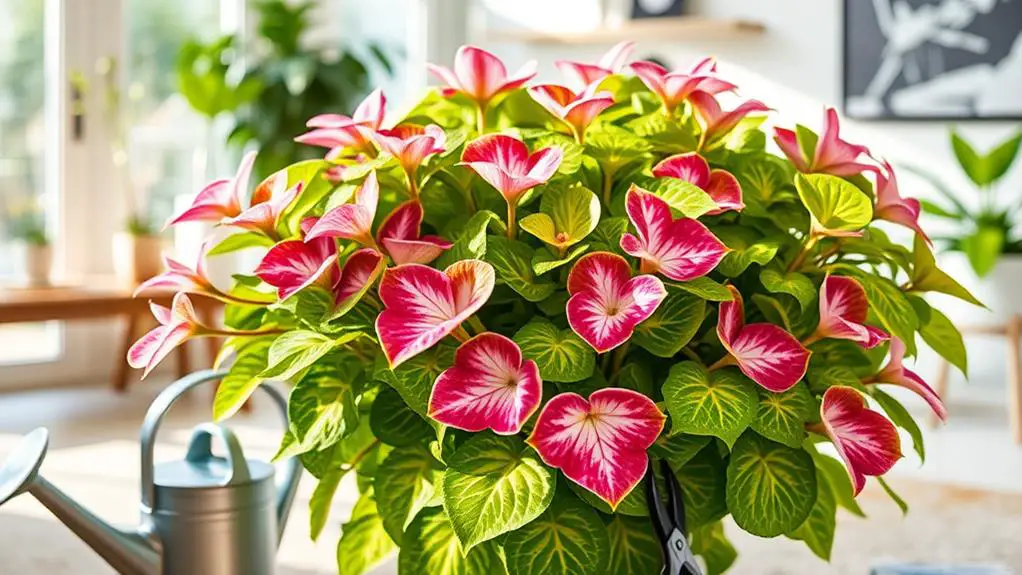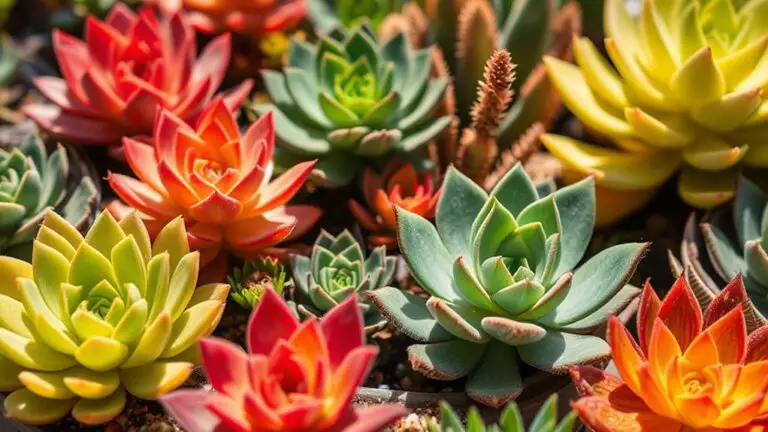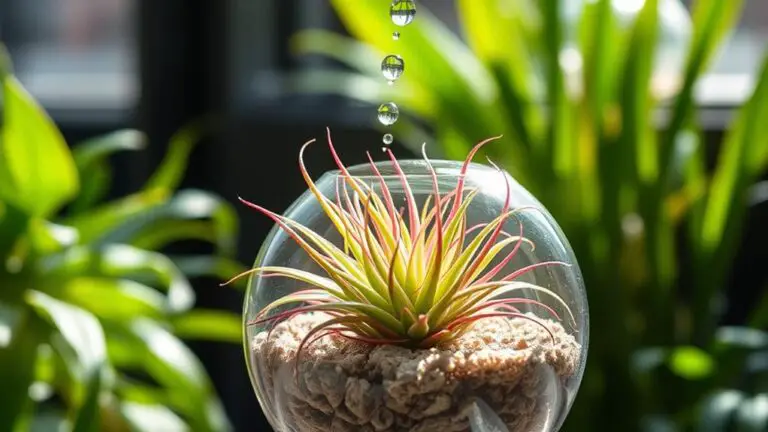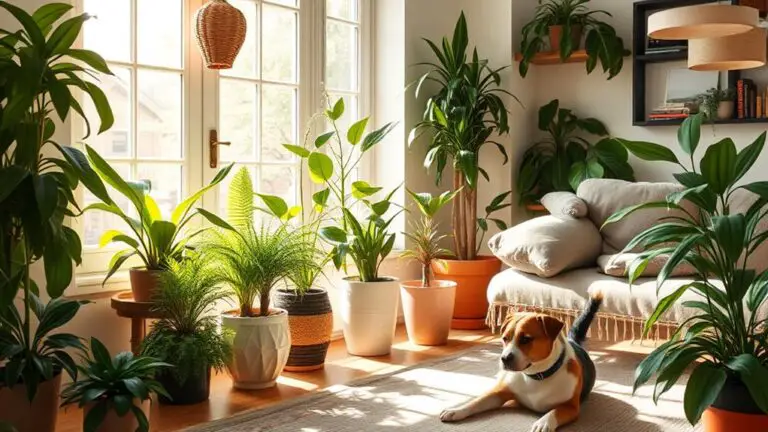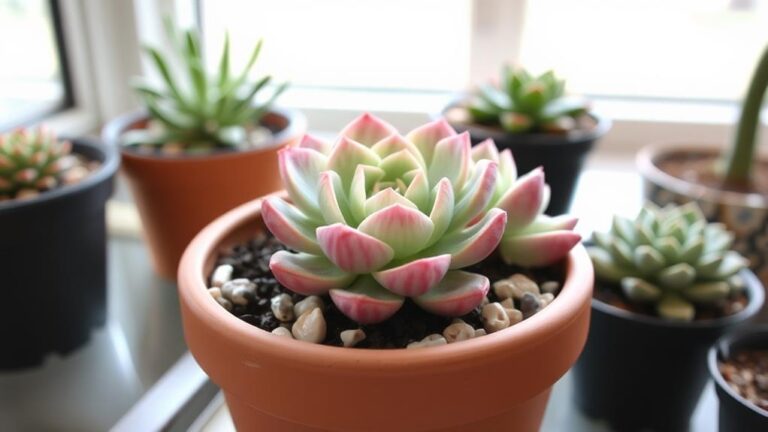Tradescantia Nanouk Care – A Complete How-To Guide
Caring for your Tradescantia Nanouk can seem challenging, but with the right approach, it's quite manageable. You'll need to focus on providing bright, indirect light and mastering the watering technique to avoid root rot. Ensuring your plant has well-draining soil and keeping an eye on humidity levels will also play an important role. But that's just the beginning; understanding the nuances of propagation and addressing common issues like pests are equally important. Ready to transform your plant care routine and see your Tradescantia Nanouk thrive? Let's explore each step in detail.
Plant Care Essentials
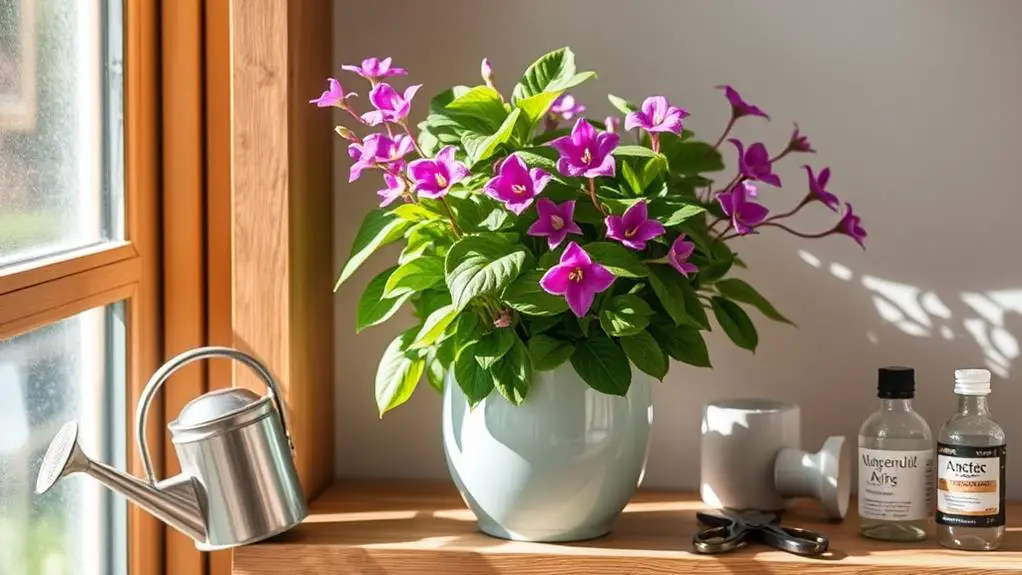
When caring for Tradescantia Nanouk, it's essential to focus on providing the right light, water, and humidity levels.
Tradescantia Nanouk thrives in bright, indirect light. Place it near windows with filtered sunlight to keep its foliage vibrant. Direct sunlight can scorch the leaves, so make sure the light isn't too harsh.
Watering is another key aspect. Care for Tradescantia by watering when the top inch of soil feels dry. Stick your finger into the soil to check. When you water, do it thoroughly but avoid wetting the leaves. This helps prevent problems like rot and fungus gnats.
Humidity levels also play an important role. Tradescantia Nanouk prefers average to high humidity. You can boost humidity by misting the plant regularly or using a humidifier, especially during dry seasons. This helps keep the plant healthy and happy.
Lastly, use well-draining potting soil for your Tradescantia Nanouk. A mix with perlite or coarse sand works well. This promotes healthy root growth and helps prevent root rot.
Regular monitoring is essential. Watch for signs like yellowing leaves from overwatering or leggy growth from insufficient light. With these tips, your Tradescantia Nanouk will thrive!
Best Growing Conditions
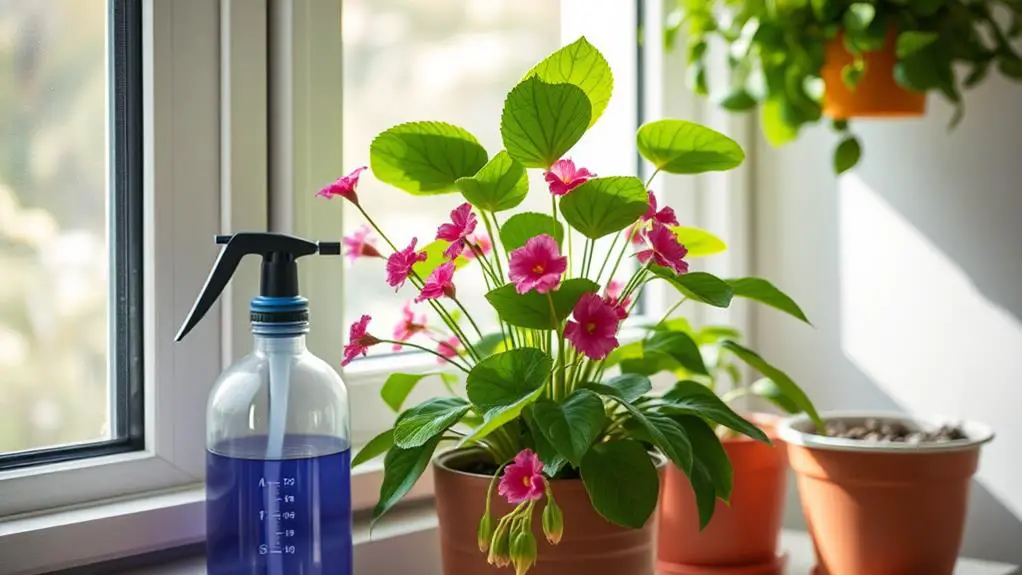
To guarantee your Tradescantia Nanouk flourishes, you need to provide the best growing conditions. Start by placing it in bright indirect light. A spot near a north or east-facing window works perfectly, helping the plant's foliage stay vibrant.
Daytime temperatures should be up to 75°F, while nighttime temperatures in the mid-50s are ideal. Don't forget about humidity levels; aim for around 50% to keep your plant happy.
Next, focus on the soil. A well-draining potting mix is essential for healthy root development. You can improve drainage by adding perlite or coarse sand.
Annual repotting is also recommended. This gives the plant room to grow and refreshes the soil, ensuring it gets the necessary nutrients.
It's also important to monitor for signs of distress. Yellowing leaves or wilting may indicate that your Tradescantia Nanouk isn't getting the best growing conditions.
Regularly check for these signs and make adjustments as needed. By providing the right light, temperature, humidity, and soil, you're setting your Tradescantia Nanouk up for success.
Propagation Methods

Let's talk about how to propagate your Tradescantia Nanouk using stem cuttings.
Start by selecting healthy stems with a few sets of leaves, then make a diagonal cut near the base of the stem.
Place the cuttings in water or well-draining soil, keeping them in a warm spot with bright, indirect light until roots form.
Taking Stem Cuttings
Propagating your Tradescantia Nanouk can be a rewarding way to expand your plant collection. To get started, you'll need to take stem cuttings. Follow these steps to guarantee success:
- Select Healthy Stems: Choose a healthy stem with a few sets of leaves. Make a diagonal cut near the base to encourage root growth.
- Prepare the Cuttings: Remove the bottom leaves to prevent rot, leaving a few sets of leaves intact. This helps the cutting focus its energy on forming new roots.
- Place in Water or Soil: You can place the cuttings in water or well-draining soil. Guarantee they receive bright, indirect light and keep the environment warm.
- Monitor and Transplant: Regularly check the cuttings for new growth and signs of distress. Once the roots are at least 2 inches long, transplant them into soil for a fuller, established plant.
For proper care, make certain the new cuttings are in well-draining soil and kept in bright, indirect light. This encourages robust growth and helps prevent issues like root rot.
With patience and attention, your Tradescantia cuttings will thrive, offering you a beautiful addition to your plant collection.
Rooting in Water
Rooting Tradescantia Nanouk in water is a straightforward and effective propagation method. Start by selecting a healthy stem with a few sets of leaves and make a diagonal cut near the base. This diagonal cut helps increase the surface area for water absorption.
Next, remove the bottom leaves from the cutting, ensuring at least two sets of leaves remain at the top. Place the cutting in a container of water, making sure the cut end is submerged.
Position the container in a warm area with bright, indirect light. This light promotes faster root development. Remember to change the water every few days to prevent stagnation and keep it fresh. Stagnant water can hinder root growth and cause the cutting to rot.
After about 2-4 weeks, you should see roots that are at least 2 inches long. At this point, it's time to transfer the cutting to well-draining soil. This will provide the necessary nutrients and environment for ideal growth.
Carefully plant the cutting in the soil and continue to provide bright, indirect light. With these steps, you'll successfully propagate your Tradescantia Nanouk and enjoy a thriving, beautiful plant.
Common Growing Problems
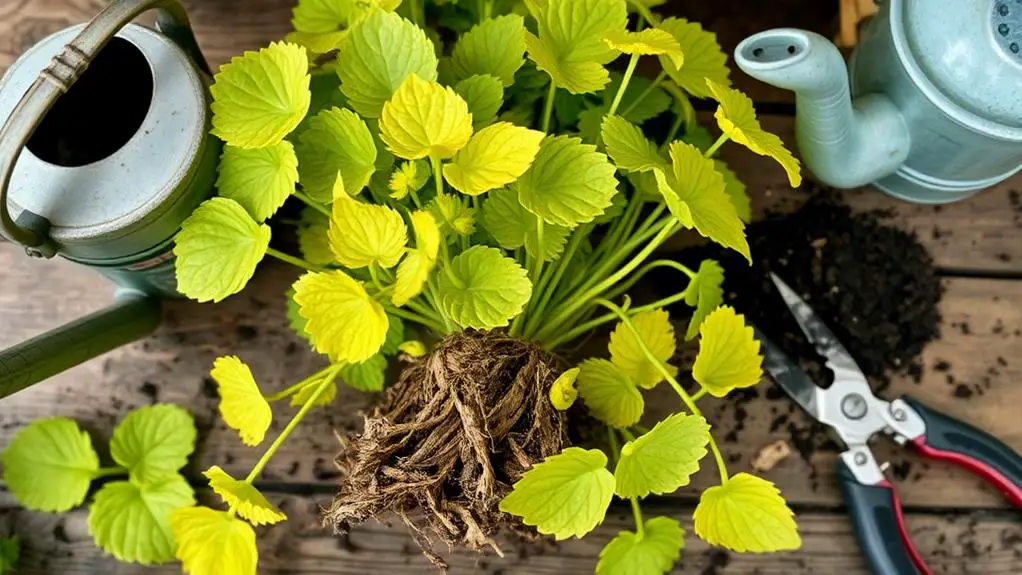
When caring for your Tradescantia Nanouk, watch out for some common growing problems.
Overwatering can cause yellow leaves and root rot, so let the top inch of soil dry out before watering again.
Also, make certain your plant gets enough light to prevent leggy growth, and check regularly for pests like spider mites if the air is too dry.
Root Rot Prevention
Root rot is a common problem you need to guard against when caring for Tradescantia Nanouk. One of the main causes is overwatering, which can lead to fungal issues and excess moisture around the roots.
To keep your plant healthy, make certain you're providing adequate drainage and keeping an eye on moisture levels. Here are some steps you can take to prevent root rot:
- Make Certain Adequate Drainage: Make sure your pot has drainage holes. This prevents water from sitting at the bottom, which can lead to root rot. Avoid letting water accumulate in the saucer beneath your pot.
- Water Wisely: Only water the plant when the top inch of soil feels dry. This balance keeps the soil slightly moist but not soggy, reducing the risk of overwatering.
- Use Well-Draining Potting Mix: A mix enhanced with perlite or coarse sand improves aeration and drainage. This helps prevent excess moisture from building up around the roots.
- Monitor Moisture Levels: Check for signs of overwatering, such as yellowing leaves or a mushy texture. Adjust your watering routine to maintain ideal moisture levels and prevent fungal issues.
Pest Management Tips
Pests can be a real nuisance when caring for your Tradescantia Nanouk. Regularly inspect your plant for signs of pests like spider mites and mealybugs, especially in warm and dry conditions where they thrive.
Healthy plants are generally more resistant to pest problems, so maintaining consistent watering and feeding practices is essential for good plant health.
If you spot any pests, act quickly. Neem oil or insecticidal soap are effective treatments for pest infestations when caught early. Simply apply as directed and be consistent to make sure the pests don't come back.
To prevent pest problems from the start, always quarantine new plants for at least two weeks before adding them to your collection. This helps you catch any pests before they spread to your other plants.
Monitoring humidity levels is also important. Low humidity can attract spider mites, while overly humid conditions can lead to fungal issues. Aim for a balanced environment to keep your Tradescantia Nanouk happy and pest-free.
Light and Watering**
Proper light and watering are essential for your Tradescantia Nanouk's health and vibrancy. This plant thrives in bright, indirect light, needing 6-8 hours a day to keep its foliage vibrant and prevent leggy growth.
When it comes to watering, wait until the top inch of soil feels dry, usually about once a week. Be careful not to wet the leaves, as this can cause brown spots and fungal problems.
Here are some tips to help you maintain the best conditions for your Tradescantia Nanouk:
- Light: Make sure your plant gets bright, indirect light for 6-8 hours daily. Too much direct sunlight can scorch the leaves.
- Watering: Water when the soil's top inch is dry. Avoid overwatering to prevent yellow leaves and root rot, especially during winter when the plant needs less moisture.
- Drainage: Use pots with drainage holes to prevent standing water, which can lead to root rot. Proper drainage is vital for healthy root development.
- Humidity: Monitor humidity levels. While typical household humidity is usually sufficient, dry leaf edges may indicate a need for more humidity.
Soil and Potting Tips
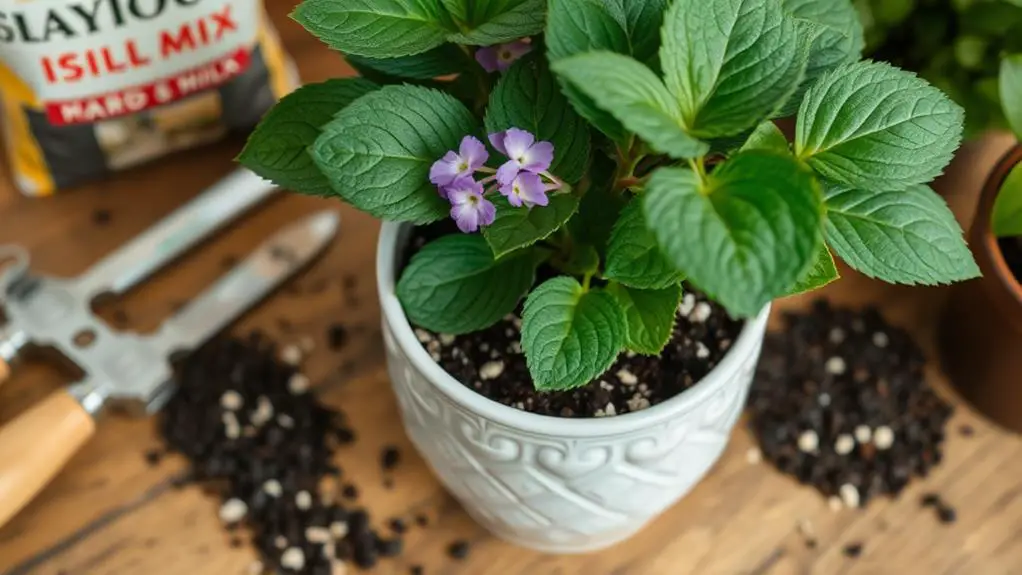
A key factor in successfully growing Tradescantia Nanouk is providing it with a well-draining potting mix, enhanced with perlite or coarse sand to improve drainage and aeration. This helps prevent water from sitting in the soil, which can lead to root rot.
Regularly check the soil moisture; it should remain slightly moist but not soggy. Using pots with drainage holes is essential to avoid standing water, which can harm your plant.
Repot the plant every year or two. This refreshes the soil and gives the roots more space, especially if they're starting to circle the pot. When repotting, choose a potting mix that suits the plant's needs. A mix with a soil pH between 6.0 and 7.0 is ideal, as this range supports healthy growth and nutrient absorption.
If you notice the soil drying out too quickly or staying too wet, adjust the mixture. Adding perlite or coarse sand can enhance drainage and help maintain the right soil moisture levels.
Toxicity Considerations
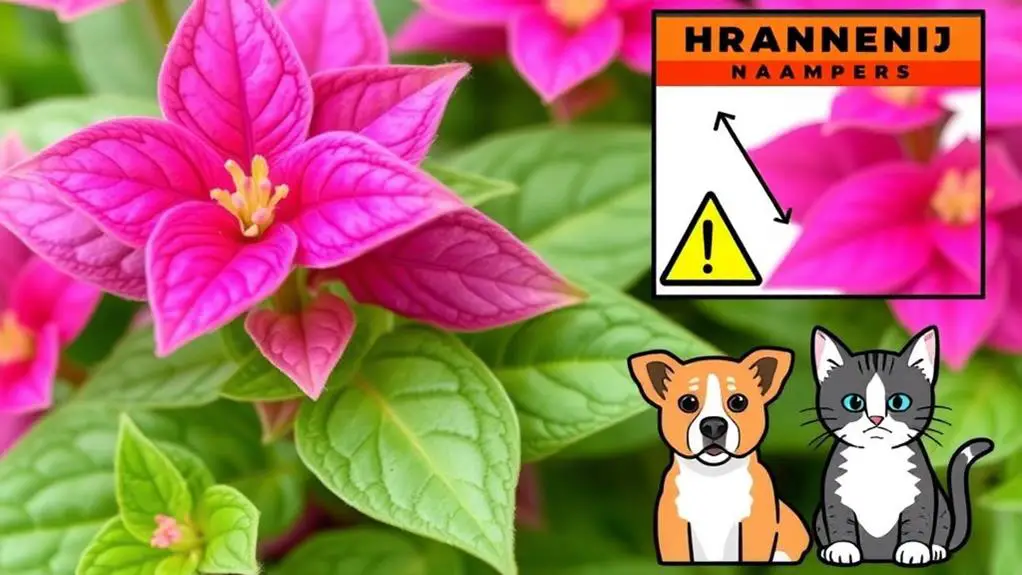
After you've confirmed your Tradescantia Nanouk is thriving in the right soil, it's important to be aware of its toxicity. This plant is mildly toxic if ingested, which means it can cause issues like gastrointestinal upset in pets and children. Symptoms might include vomiting or diarrhea, so it's essential to take steps to guarantee a safe home environment.
To help keep your household safe, consider these steps:
- Placement: Keep your Tradescantia Nanouk out of reach. High shelves or hanging planters work well to prevent accidental ingestion by curious pets and children.
- Education: Inform family members and guests about the plant's mildly toxic nature. Awareness can help everyone avoid unnecessary risks.
- Monitoring: Regularly check the plant's location. Make sure it's still out of reach and hasn't been moved by accident.
- Alternative Plants: If you're worried about the risk, consider opting for non-toxic plants. There are many beautiful, pet-friendly options available.
While Tradescantia Nanouk isn't lethal, being proactive about toxicity considerations guarantees a happier, healthier home for everyone. By taking these precautions, you can enjoy the beauty of your plant without worries.
Frequently Asked Questions
How Do You Take Care of a Tradescantia Nanouk?
Place your Tradescantia Nanouk in bright, indirect light for 6-8 hours daily. Water using the soak and dry method. Maintain moderate humidity and temperatures between 65°F to 75°F. Use well-draining soil and regularly prune for bushier growth.
How to Make Tradescantia Nanouk More Pink?
To make your Tradescantia Nanouk more pink, guarantee it gets 6-8 hours of bright, indirect sunlight daily. Position it near a southeast window, rotate it regularly, maintain ideal temperatures, and fertilize monthly during the growing season.
Do Tradescantia Nanouk Like to Be Misted?
Tradescantia Nanouk doesn't need misting since it tolerates regular household humidity well. If your environment is extremely dry, mist sparingly with room temperature water. Avoid pooling water at leaf bases to prevent rot and fungal issues.
Why Are the Leaves on My Nanouk Plant Turning Brown?
Your Nanouk plant's leaves might be turning brown due to underwatering, overwatering, direct sunlight, or low humidity. Make certain you water when the top inch is dry, provide bright indirect light, and maintain around 50% humidity.
Conclusion
You've got everything you need to help your Tradescantia Nanouk thrive! With the right light, watering, and soil, your plant will stay healthy and vibrant. Remember to keep an eye on humidity and check for pests regularly. Don't be afraid to try propagating your plant; it's easier than you think. Just follow these tips, and you'll be a pro in no time. Happy gardening, and enjoy your beautiful Tradescantia Nanouk!

